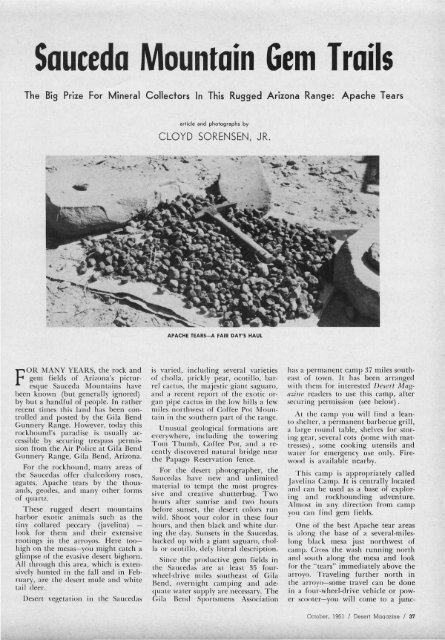OUTDOOR SOUTHWEST - Desert Magazine of the Southwest
OUTDOOR SOUTHWEST - Desert Magazine of the Southwest
OUTDOOR SOUTHWEST - Desert Magazine of the Southwest
You also want an ePaper? Increase the reach of your titles
YUMPU automatically turns print PDFs into web optimized ePapers that Google loves.
Sauceda Mountain Gem Trails<br />
The Big Prize For Mineral Collec+ors In This Rugged Arizona Range: Apache Tears<br />
FOR MANY YEARS, <strong>the</strong> rock and<br />
gem fields <strong>of</strong> Arizona's picturesque<br />
Sauceda Mountains have<br />
been known (but generally ignored)<br />
by but a handful <strong>of</strong> people. In ra<strong>the</strong>r<br />
recent times this land has been controlled<br />
and posted by <strong>the</strong> Gila Bend<br />
Gunnery Range. However, today this<br />
rockhound's paradise is usually accessible<br />
by securing trespass permission<br />
from <strong>the</strong> Air Police at Gila Bend<br />
Gunnery Range, Gila Bend, Arizona.<br />
For <strong>the</strong> rockhound, many areas <strong>of</strong><br />
<strong>the</strong> Saucedas <strong>of</strong>fer chalcedony roses,<br />
agates, Apache tears by <strong>the</strong> thousands,<br />
geodes, and many o<strong>the</strong>r forms<br />
<strong>of</strong> quartz.<br />
These rugged desert mountains<br />
harbor exotic animals such as <strong>the</strong><br />
tiny collared peccary (javelina) —<br />
look for <strong>the</strong>m anil <strong>the</strong>ir extensive<br />
rootings in <strong>the</strong> arroyos. Here toohigh<br />
on <strong>the</strong> mesas—you might catch a<br />
glimpse <strong>of</strong> <strong>the</strong> evasive desert bighorn.<br />
All through this area, which is extensively<br />
hunted in <strong>the</strong> fall and in February,<br />
are <strong>the</strong> desert mule and white<br />
tail deer.<br />
<strong>Desert</strong> vegetation in <strong>the</strong> Saucedas<br />
article and photographs by<br />
CLOYD SORENSEN, JR.<br />
APACHE TEARS-A FAIR DAY'S HAUL<br />
is varied, including several varieties<br />
<strong>of</strong> cholla, prickly pear, ocotillo, barrel<br />
cactus, <strong>the</strong> majestic: giant saguaro,<br />
and a recent report <strong>of</strong> <strong>the</strong> exotic organ<br />
pipe cactus in <strong>the</strong> low hills a few<br />
miles northwest <strong>of</strong> C<strong>of</strong>fee Pot Mountain<br />
in <strong>the</strong> sou<strong>the</strong>rn part <strong>of</strong> <strong>the</strong> range.<br />
Unusual geological formations are<br />
everywhere, including <strong>the</strong> towering<br />
Tom Thumb, C<strong>of</strong>fee Pot, and a recently<br />
discovered natural bridge near<br />
<strong>the</strong> Papago Reservation fence.<br />
For <strong>the</strong> desert photographer, <strong>the</strong><br />
Saucedas have new and unlimited<br />
material to tempt <strong>the</strong> most progressive<br />
and creative shutterbug. Two<br />
hours after sunrise and two hours<br />
before sunset, <strong>the</strong> desert colors run<br />
wild. Shoot your color in <strong>the</strong>se four<br />
hours, and <strong>the</strong>n black and white during<br />
<strong>the</strong> day. Sunsets in <strong>the</strong> Saucedas,<br />
backed up with a giant saguaro, cholla<br />
or ocotillo, defy literal description.<br />
Since <strong>the</strong> productive gem fields in<br />
<strong>the</strong> Saucedas are at least 35 fourwheel-drive<br />
miles sou<strong>the</strong>ast <strong>of</strong> Gila<br />
Bend, overnight camping and adequate<br />
water supply are necessary. The<br />
Gila Bend Sportsraens Association<br />
has a permanent camp 37 miles sou<strong>the</strong>ast<br />
<strong>of</strong> town. It has been arranged<br />
with <strong>the</strong>m for interested <strong>Desert</strong> <strong>Magazine</strong><br />
readers to use this camp, after<br />
securing permission (see below).<br />
At <strong>the</strong> camp you will find a leanto<br />
shelter, a permanent barbecue grill,<br />
a large round table, shelves for storing<br />
gear, several cots (some with mattresses)<br />
, some cooking utensils and<br />
water for emergency use only. Firewood<br />
is available nearby.<br />
This camp is appropriately called<br />
Javelina Camp. It is centrally located<br />
and can be used as a base <strong>of</strong> exploring<br />
and rockhounding adventure.<br />
Almost in any direction from camp<br />
you can find gem fields.<br />
One <strong>of</strong> <strong>the</strong> best Apache tear areas<br />
is along <strong>the</strong> base <strong>of</strong> a several-mileslong<br />
black mesa just northwest <strong>of</strong><br />
camp. Cross <strong>the</strong> wash running north<br />
and south along <strong>the</strong> mesa and look<br />
for <strong>the</strong> "tears" immediately above <strong>the</strong><br />
arroyo. Traveling fur<strong>the</strong>r north in<br />
<strong>the</strong> arroyo—some travel can be done<br />
in a four-wheel-drive vehicle or power<br />
scooter—you will come to a junc-<br />
October, 1961 / <strong>Desert</strong> <strong>Magazine</strong> / 37

















